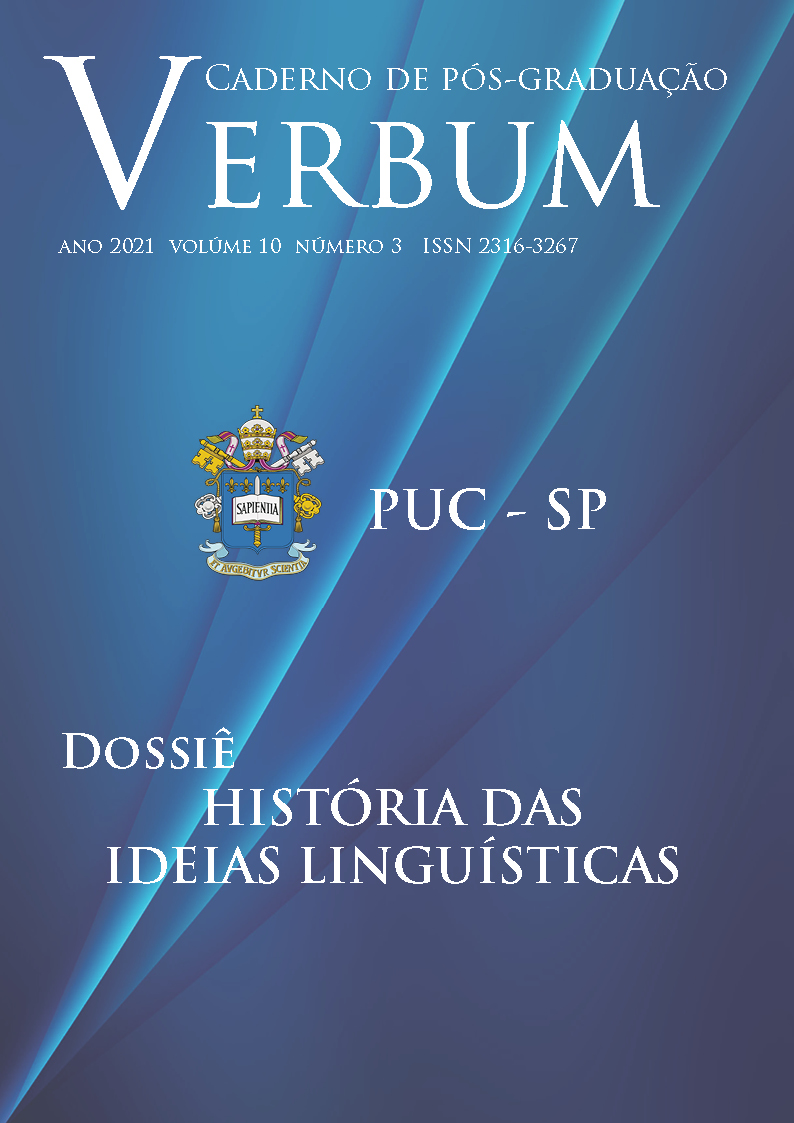ESTUDO DA GRAMMATICA ANALYTICA E EXPLICATIVA DE LINGUA PORTUGUESA (Pardal e Ortiz – 1884)
DOI:
https://doi.org/10.23925/2316-3267.2021v10i3p13-24Palavras-chave:
Gramática Analítica e explicativa de Língua Portuguesa, Conceitos Gerais, Morfologia, SintaxeResumo
O objetivo deste trabalho é o de analisar a Gramática Analítica e Explicativa de Língua Portuguesa, dos professores Pardal e Ortiz , avaliando a constituição da obra, no que se refere aos conceitos de Gramática, sua divisão e, na sequência, em relação aos postulados de morfologia e sintaxe, visto que a edição da obra analisada é a quinta, datada de 1884, quando imperavam os pressupostos da gramática tradicional, naquela instância em que o Brasil estava numa monarquia, mas gritava pela República e passava por uma reconfiguração nos âmbitos sociais, econômicos e sobretudo educacionais. Algumas reformas começavam a ser implementadas na Escola e a sociedade, formada sobretudo por letrados, que deixavam agora estudarem seus filhos no Brasil para que alcançassem o Ensino Superior, nas poucas faculdades que surgiam. O método de norteia este trabalho é o descritivo-analítico, seguindo os pressupostos teóricos da História das Ideias Linguísticas (AUROUX, 1989;1992; FÁVERO e MOLINA: 2004,2006,2019; ORLANDI e GUIMARÃES , 1996, ORLANDI, 2002 e COLOMBAT, FOURNIER e PUECH,2010).
Referências
ARNAULD, A.E LANCELOT, C. Gramática de Port-Royal: gramática geral e razoada.Tradução de Bruno Basseto e Henrique G. Murachco. São Paulo: Martins Fontes, 1992 [1660].
AUROUX, S. A. Revolução Tecnológica da Gramatização. Campinas: Editora da UNICAMP, 1992.
AUROUX, S. Histoire des Idées Linguistiques. Paris: Pierre Mardaga Editeur, Tomo1, 1989.
BRASIL. Ministério do Império. Relatórios apresentados à Assembléia Geral Legislativa. Rio de Janeiro: Typ Laemmert, 1850-1889.
CAVALIERE, R. Fonologia e Morfologiana Gramática Científica Brasileira.Rio de Janeiro: Editora da Universidade Federal do RJ, 2000.
CAVALIERE, R. A gramática no Brasil: ideias, percursos e parâmetros. Rio de Janeiro: Lexicon, 2014.
COLOMBAT, B.; FOURNIER, J.M.;PUECH, C. Histoire des idées sur les langues et les langages. Paris, Klincksieck, 2010.
FÁVERO, L. L. As Concepções Linguísticas no Século XVIII: a gramática Portuguesa. Campinas: Editora da Unicamp, 1996.
FÁVERO, L. L. Gramática é a Arte. In: ORLANDI, E.P. (org.). História das ideias linguísticas no Brasil–Construção do Saber Metalinguístico e Constituiçãoda Língua Nacional. 1. ed. Campinas, SP: Pontes; Cáceres, MT: Unemat Editora, 2001. p. 59-70.
FÁVERO, L. L.; MOLINA, M. A. G. História das Ideias Linguísticas: origem, método e limitações. Revista da Anpoll, n. 16, p. 131 a 146, 2004.
FÁVERO L. L. ; MOLINA, M. A. G. As concepções Linguísticas no Século XIX: A Gramática no Brasil. Rio de Janeiro: Editora Lucerna, 2006.
FÁVERO, L. L.; MOLINA, M. A. G. As concepções linguísticas no Brasil no século XIX e início do XX: Gramáticas da Infância. São Paulo: Terracota, 2019.
FÁVERO, L. L.; MOLINA, M. A. G. Conhecimento linguístico: século XIX: tradição e modernidade? Disponível em: http://www.scielo.edu.uy/scielo.php?script=sci_arttext&pid=S2079-312X2013000100009. Acesso em 07 dez. 2021.
NEBRIJA, E. A. de. Gramática Castellana. Madri, Fundación Antonio de Nebrija, 1992 [1492].
ORLANDI, E. P.; GUIMARÃES, E. Identidade Linguística, in: Língua e Cidadania.Campinas: Editora Pontes, 1996.
ORLANDI, E. P.; GUIMARÃES, E. (orgs.). Institucionalização dos Estudos da Linguagem: A disciplinarização das Ideias Linguísticas. Campinas: Pontes, 2002.
ORLANDI, E. P. Discurso e Texto: formação e circulação do sentido. Campinas, SP: Pontes, 2001.
ORLANDI, E. Língua e conhecimento linguístico: para uma história das ideias no Brasil.São Paulo, Cortez, 2002.
PARDAL, C. M. F.; ORTIZ, J. Grammática analytica e explicativa da língua portuguesa. 5. ed. Rio de Janeiro, 1884 [1871].
POLACHINI, S. B. Uma história serial e conceitual da gramática brasileira oitocentista de língua portuguesa, 2018. 457p. Tese(Doutorado em Letras) – Programa de Semiótica e Linguística Geral, Universidade de São Paulo, São Paulo, 2018.


